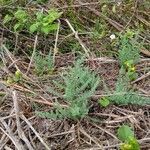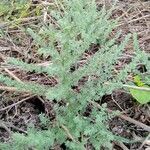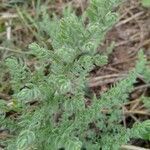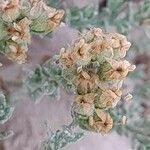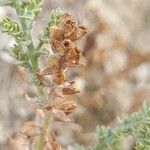An erect or dilfuse, much-branched perennial, sometimes almost woody at the base, c. 20 cm, strigose appressed-hairy all over. Leaves subsessile to shortly petioled, elliptic-oblong or slightly oblong-obovate, acutish, 5-9 by 3-4 mm. Bracteoles ovate-oblong. Flowers sessile, in terminal heads. Sepals broadly obovate, obtuse, ciliate, 3.5 mm long. Corolla shortly exceeding the calyx, hairy outside, 5.5-6 mm long. Anthers oblong, c. 1 1/3-1.5 mm long.
A slender sub-shrub or herb. It grows 10-30 cm high. It can be erect or spreading. It has a tough woody rootstock. It can keep growing from year to year. The leaves are greyish and hairy. They are oval or sword shaped and have a heart shaped base. They do not have teeth. The flowers are yellow or pink. The flowers are borne in round clusters at the ends of branches. The corolla has a short tube and 5 spreading lobes which may curve back.
Leaves sessile, ovate-lanceolate to ovate, 2–7 × 1–4 mm., acute at the apex, cuneate, rounded or even subcordate at the base, grey-green appressedly pubescent.
Corolla about 5 mm. long; tube and lobes about equal, the first enveloped by the calyx; lobes oblong-ovate, hairy on the outside.
Stems woody at base, terete, slender, with numerous spreading or ascending, hairy, densely-leaved branchlets.
Stems woody below, slender, spreading or ascending from a few inches to 1 ft. long
Stamens and styles rather longer than the corolla.
Flowers aggregated at the ends of the branchlets.
Sepals concave, abruptly acute, silky pubescent.
Capsule ovoid, pilose at the apex.
Calyx ovoid 3–4 mm. long.
Seed ovoid.
